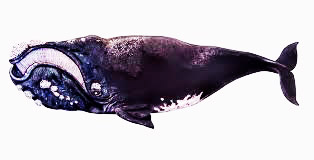Right Whale

Common Name: Right Whale
Scientific Name: Eubalaena glacialis
Right Whale : Description
The Right Whale are the rarest of all large whale species and among the rarest of all marine mammal species.They are large baleen whales.Distinguishing features for right whales include a stocky body, generally black coloration and although some individuals have white patches on their undersides, lack of a dorsal fin, a large head strongly bowed margin of the lower lip, and callosities on the head region.
Right Whale : Diet
Right whales feed from spring to fall, and also in winter in certain areas. The primary food sources are zooplankton, including copepods, euphausiids, and cyprids.
Right Whale : Reproduction
In western North Atlantic population numbers about 300-400 individual right whales.By recent analysis , data suggests a slight growth in population size
Right Whale : Habitat
There are four categories of right whale habitats:
Feeding - areas with copepod and krill densities that routinely elicit feeding behavior and are visited seasonally.
Calving - areas routinely used for calving and neonatal nursing.
Nursery - aggregation areas where nursing females feed and suckle.
Breeding - locations where mating behavior leading to conception occurs, breeding areas are not known for any population.
Large males will often take on the most dangerous jobs when tackling potentially dangerous prey, but females appear to be responsible for teaching hunting techniques to their young.
Right Whale : Biology
Females are larger than males.
Sexually mature at around age 10.
Produce one offspring every 3 to 5 years.
Filter feeders using baleen plates.
Feed on dense patches of zooplankton called copepods.
Nurse for 10-12 months.
Capable of living more than 100 years
 Deep Sea Crabs
Deep Sea Crabs